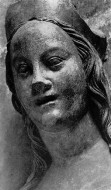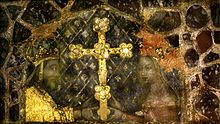Anna von Schweidnitz: Difference between revisions
m →top: http→https for Google Books and Google News using AWB |
Rescuing 1 sources and tagging 0 as dead. #IABot (v1.2.5) |
||
| Line 76: | Line 76: | ||
==External links== |
==External links== |
||
{{Commons category|Anne of Świdnica|Anna von Schweidnitz}} |
{{Commons category|Anne of Świdnica|Anna von Schweidnitz}} |
||
*[http://www.genealogie-mittelalter.de/deutschland_koenige_2/anna_deutsche_koenigin_1362_piasten_luxemburger/anna_von_schweidnitz_jauer_deutsche_koenigin_+_1362.html genealogie-mittelalter.de] |
*[https://web.archive.org/web/20071001004624/http://www.genealogie-mittelalter.de/deutschland_koenige_2/anna_deutsche_koenigin_1362_piasten_luxemburger/anna_von_schweidnitz_jauer_deutsche_koenigin_+_1362.html genealogie-mittelalter.de] |
||
*http://www.boehm-chronik.com/grundherrschaft/landbuch.htm |
*http://www.boehm-chronik.com/grundherrschaft/landbuch.htm |
||
Revision as of 18:18, 14 October 2016
| Anna of Świdnica | |
|---|---|
| Holy Roman Empress; Queen consort of Germany and Bohemia | |
 | |
| Tenure | 1353–1362 |
| Born | c. 1339 Świdnica |
| Died | 11 July 1362 (aged 22 or 23) Prague, Bohemia |
| Spouse | Charles IV, Holy Roman Emperor |
| Issue | Wenceslaus, King of the Romans Elisabeth of Bohemia |
| House | House of Luxembourg House of Piast |
| Father | Henry II of Świdnica |
| Mother | Katharina of Hungary |

Anna of Schweidnitz (Świdnica)[1][2][3][4] (also known as Anne or Anna of Świdnica,[5][6][7][8][9][10][11][12][13] Czech: Anna Svídnická, Template:Lang-pl, German: Anna von Schweidnitz und Jauer) (Świdnica, 1339 – 11 July 1362 in Prague) was Queen of Bohemia, German Queen, and Empress of the Holy Roman Empire. She was the third wife of Emperor Charles IV.
Biography
Anne was the daughter of Polish Duke Henry II of Świdnica-Jawor from the Silesian branch of the Piast dynasty. Her mother was Katherine of Hungary, the daughter of Charles I of Hungary. In his autobiography written in Latin,[14] which covers only his youth prior to getting married to Anna, emperor Charles mentions civitatem Swidnitz and dux Swidnicensis, as depicted in the coat of arms room[15] of his Wenzelschloss castle at Lauf an der Pegnitz near Nuremberg.
Anne's father died when she was four years old, and her childless uncle, Bolko II, Duke of Świdnica-Jawor became her guardian. She was brought up and educated by her mother at Visegrád in Hungary. At the age of 11, Anne had been promised to Wenceslaus, newborn son and successor to Charles IV. After the infant Wenceslaus and his mother Anna of the Palatinate died, the now-widowed Emperor asked to marry Anne himself. The planned marriage was part of the strategies devised by Charles and his then-deceased father John to gain control of the Piast Duchies of Silesia as vedlejší země ("neighboring countries") for the Kingdom of Bohemia. Anne's uncle, Louis of Hungary, the future King of Poland, was able to assist her by renouncing his rights to Świdnica in favor of the House of Luxemburg.

At the instigation of archbishop Arnošt of Pardubice, Pope Innocent VI issued a dispensation for the marriage, which was required because of the degree of relationship between the bride and groom (they were second cousins once removed through their common ancestors Rudolph I of Germany and Gertrude of Hohenburg). The two were married on 27 May 1353, when Anne was 14; her new husband was 37. The wedding was attended by Anne's guardian Bolko II of Świdnica, Duke Albert II of Austria, King Louis of Hungary, Margrave Louis of Brandenburg, Duke Rudolf of Saxony, an envoy of King Casimir III of Poland, and an envoy of the Republic of Venice.
On 28 July 1353, Anna was crowned Queen of Bohemia in Prague by Archbishop Arnošt of Pardubice. On 9 February 1354, in Aachen, she was crowned German queen. As part of the coronation of Charles as Holy Roman Emperor on 5 April 1355, in the Roman Basilica of Saint Peter, Anne was crowned Empress of the Holy Roman Empire. She was thereby the first Queen of Bohemia to become Empress.
In 1358, Anne bore a daughter, Elisabeth, who was named after Elisabeth of Bohemia (1292–1330). In February 1361 she became mother of the desired successor to the throne, Wenceslaus, who was born in Nuremberg, and baptized on 11 April in the Sebalduskirche by the Archbishops of Prague, Cologne, and Mainz. She did not live to see the coronation of the two-year-old Wenceslaus, however. At the age of only 23 years, she died in childbirth on 11 July 1362. She is buried in St. Vitus Cathedral. The emperor married Elisabeth of Pomerania one year later. The Duchies of Świdnica and Jawor passed to Bohemia after Bolko's death in 1368.
Ancestry
| Anna von Schweidnitz | Father: Henry II of Świdnica |
Paternal Grandfather: Bernard of Świdnica |
Paternal Great-Grandfather: Bolko I of Świdnica |
| Paternal Great-grandmother: Beatrice of Brandenburg | |||
| Paternal Grandmother: Kunigunde of Poland |
Paternal Great-Grandfather: Władysław I the Elbow-high | ||
| Paternal Great-Grandmother: Jadwiga of Greater Poland | |||
| Mother: Katharine of Hungary |
Maternal Grandfather: Charles I of Hungary |
Maternal Great-Grandfather: Charles Martel of Anjou | |
| Maternal Great-Grandmother: Klementia of Habsburg | |||
| Maternal Grandmother: ? |
Maternal Great-grandfather: ? | ||
| Maternal Great-Grandmother: ? |
References
- ^ John M. Jeep: Medieval Germany: An Encyclopedia, Published by Routledge, 2001 ISBN 0-8240-7644-3, ISBN 978-0-8240-7644-3 [1]
- ^ Virginia Chieffo Raguin, Sarah Stanbury: Women's Space: Patronage, Place, and Gender in the Medieval Church, Published by SUNY Press, 2005, ISBN 0-7914-6365-6, ISBN 978-0-7914-6365-9 [2]
- ^ David E. Wellbery, Judith Ryan, Hans Ulrich Gumbrecht et al.: Published by Belknap Press of Harvard University Press, 2004, ISBN 0-674-01503-7, ISBN 978-0-674-01503-6 [3]
- ^ Richard Kenneth Emmerson, Sandra Clayton-Emmerson: Key Figures in Medieval Europe: An Encyclopedia, Published by CRC Press, 2006 ISBN 0-415-97385-6, ISBN 978-0-415-97385-4 [4]
- ^ Template:En icon John M. Jeep (2001). Routledge (ed.). Medieval Germany. pp. :110. ISBN 0-8240-7644-3.
{{cite book}}: Cite has empty unknown parameter:|chapterurl=(help)Google Books - ^ Template:En icon Maria Prokopp (1984). Michigan University (ed.). Italian Trecento Influence on Murals in East Central Europe, Particularly Hungary. Michigan: Akademiai Kiado. pp. :58, 71. ISBN 963-05-3059-7.
{{cite book}}: Cite has empty unknown parameter:|chapterurl=(help)Google Books - ^ Template:En icon Gábor Klaniczay; Eva Pálmai (2002). Cambridge University Press (ed.). Holy Rulers and Blessed Princesses. Cambridge: Cambridge University Press. pp. :342. ISBN 0-521-42018-0.
{{cite book}}: Cite has empty unknown parameter:|chapterurl=(help)Google Books - ^ Template:En icon Csilla Ottlik Perczel (2001). East European Monographs (ed.). A History of Architecture in the Carpathian Basin, 1000-1920. Wirginia: University of Wirginia. pp. :56, 221. ISBN 0-88033-460-6.
{{cite book}}: Cite has empty unknown parameter:|chapterurl=(help)Google Books - ^ Template:En icon T Ulewicz (1984). Litterae et lingua: in honorem premislavi mroczkowski. Warsaw: Polish Science Academy. pp. :46.
{{cite book}}: Cite has empty unknown parameter:|chapterurl=(help)Google Books - ^ Template:En icon Norman Davies; Roger Moorhouse (2002). Jonathan Cape (ed.). Microcosm: Portrait of a Central European City. London. pp. :506, 563. ISBN 0-224-06243-3.
{{cite book}}: Cite has empty unknown parameter:|chapterurl=(help)CS1 maint: location missing publisher (link)Google Books - ^ Template:En icon Jonathan Cape, ed. (1970). "vol. 5 Carthusians-Cockcroft". Encyclopædia Britannica. London: Horace Everett Hooper. pp. :294.
{{cite book}}: Cite has empty unknown parameter:|chapterurl=(help)Google Books - ^ Template:En icon William Woys Weaver; Magdalena Thomas; Maria Dembińska (1999). Food and Drink in Medieval Poland: Rediscovering a Cuisine of the Past. Pennsylvania: University of Pennsylvania Press. pp. :39. ISBN 0-8122-3224-0.
{{cite book}}: Cite has empty unknown parameter:|chapterurl=(help)Google Books - ^ Template:En icon Paul W. Knoll (1972). The Rise of the Polish Monarchy: Piast Poland in East Central Europe, 1320-1370. Chicago: University of Chicago Press. pp. :267. ISBN 0-226-44826-6.
{{cite book}}: Cite has empty unknown parameter:|chapterurl=(help)Google Books - ^ [5]
- ^ http://www.planet-franken-online.de/wapp/seite1.jpg
Literature
- Thilo Vogelsang (1953), "Anna von Schweidnitz und Jauer", Neue Deutsche Biographie (in German), vol. 1, Berlin: Duncker & Humblot, pp. 299–299
- Andreas Rüther: Anna von Schweidnitz und Jauer. In: Schlesische Lebensbilder, Bd. VIII, ISBN 3-7686-3501-5 Template:De icon
- Peter Moraw: Anna von Schweidnitz und Jauer. In: Lexikon des Mittelalters, Bd. I, München 1980, Sp. 655 Template:De icon
- F. Machilek: Anna von Schweidnitz. In: Schweidnitz im Wandel der Zeiten, Würzburg 1990, S. 317-322 Template:De icon
External links
- Use dmy dates from December 2011
- 1339 births
- 1362 deaths
- Deaths in childbirth
- House of Piast
- Holy Roman Empresses
- Italian queens consort
- German queens consort
- Bohemian queens consort
- Luxembourgian dynasty
- Women of medieval Germany
- Burials at St. Vitus Cathedral
- Countesses of Luxembourg
- Charles IV, Holy Roman Emperor
